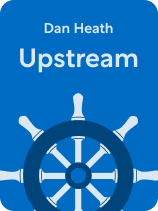

This article is an excerpt from the Shortform book guide to "Upstream" by Dan Heath. Shortform has the world's best summaries and analyses of books you should be reading.
Like this article? Sign up for a free trial here.
What is upstream thinking? Why is it a superior problem-solving strategy?
In Upstream, Dan Heath advocates for focusing energy on upstream problem-solving. He concedes that the concept of working on the root causes of problems is not always the easiest route, but it does offer the potential for improving flawed systems and reducing harm on a broader scale.
Continue reading to learn what upstream thinking is and why it’s a better way to solve problems.
Upstream Thinking
What is upstream thinking? Let’s take a look at how Heath defines it. In the central metaphor of the book, there’s a crisis happening at a specific point along a stream. For example, say there’s trash floating by, disrupting both the ecosystem and the aesthetic appeal of the water for the local community. A reactive or “downstream” solution is to continually collect the trash and dispose of it elsewhere. The drawback is that the steady flow of garbage never ends, and keeping up with it is exhausting.
On the other hand, Heath would argue that a better strategy is to walk upstream to identify the source of the problem: Where is all the trash coming from? Who is putting it there and why? Heath suggests that identifying the source of problems enables us to create more effective and longer-lasting solutions.
Heath explains that the term “upstream” is more suitable than “proactive” or “preventive” because the metaphor represents the opportunity to get continually closer to root causes. In other words, it’s not just about ending one cause-and-effect cycle but being able to endlessly zoom out to see the bigger picture and identify key points where something might be going wrong.
| Definition of Upstream Across Different Industries The metaphor of a flowing stream has proved to be useful in many industries, where the term “upstream” (and “downstream”) has been adapted in various ways for several decades. Depending on the context, it can mean “early stages” of a process or refer more specifically to preventive action geared toward long-term results (as Heath uses the term). The common thread through these different uses is the idea of differentiating the more distant causes, materials, or factors contributing to an outcome rather than the more immediate ones. In the oil and gas industry, the term “upstream” refers to the initial stages (also referred to as the exploration and production phase) of producing oil and gas. In this case, it includes scouting promising areas to drill and drilling test wells to extract resources. Similarly, in manufacturing, “upstream” refers to the earliest parts of a supply chain, like the raw inputs for production as opposed to the downstream finished products. More recently, it became a common term representing proactive intervention and the long-term impacts of those actions in health care, environmentalism, and marketing. |
Why We Need Upstream Thinking
Heath argues that people should always strive for upstream solutions because they tend to have longer-lasting benefits and provide opportunities to reduce human suffering.
Problems related to climate change illustrate this theory well. For example, if climate change continues on its current trajectory, it’s likely that some coastal communities will eventually be destroyed by natural disasters and rising sea levels.
One way to deal with this—the reactive solution—is to wait until it happens. And, if it does, try to relocate those communities farther inland. This solution deals with the problem but only at the expense of many innocent lives. On the other hand, people could go upstream by reducing the atmospheric carbon emissions that drive climate change or by changing the economic incentives that drive the use of carbon-emitting energy sources. Heath would argue that the upstream solution provides a more hopeful possibility of preventing the catastrophe altogether and providing long-term safety from climate change-related disasters.
(Shortform note: Upstream environmental efforts also demonstrate an opportunity to provide longer-term interspecies benefits. By mitigating the harmful effects of climate change, people can also maintain crucial habitats for different animals, which are increasingly threatened by changing temperatures, water levels, and food sources. Enhanced biodiversity then has a beneficial domino effect on the overall ecosystem, including humans.)
Heath makes the key point that upstream solutions will often save individuals and institutions money in the long run. However, cost-effectiveness shouldn’t be a prerequisite for upstream actions because we have a moral obligation to reduce human suffering whenever possible.
(Shortform note: Health care is one sector where this topic of cost-effectiveness versus moral obligation is heavily debated. Many people disagree about whether the ultimate goal of health systems should be to extend life as long as possible (even at a high cost) and how health systems should reduce human suffering. Health systems allocate limited resources based on the monetary costs and the benefits (such as the probability of survival and expected lifespan after treatment), but at the individual level people often want the best care possible regardless of cost-effectiveness.)

———End of Preview———
Like what you just read? Read the rest of the world's best book summary and analysis of Dan Heath's "Upstream" at Shortform.
Here's what you'll find in our full Upstream summary:
- Why you need to get to the root of a problem rather than applying band-aids
- Guidelines for implementing upstream solutions to solve problems
- How to solve problems before they happen






